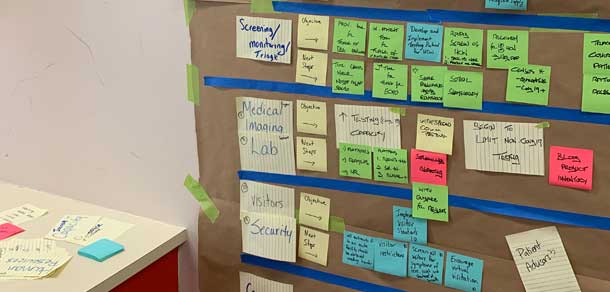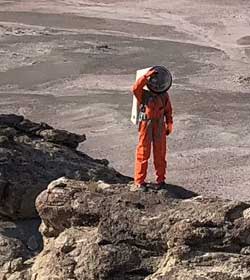TThe pandemic rules of living in isolation and going outside only when absolutely necessary are nothing new to Doug Campbell, P.Eng. The Saskatoon biomedical and mechanical engineer spent two weeks in a Mars simulation in Utah. Two metres apart is nothing compared to imagining that you are social distancing 183 million kilometres from the rest of the human race.
Campbell’s Mars simulation experience – which included being wary of potential biohazards on the Red Planet – has served him in good stead as the Deputy Planning Chief for the Saskatchewan Health Authority’s (SHA) Emergency Operations Center (EOC) after for COVID-19.
Adjusting to the new normal
Before the pandemic, Campbell was the SHA’s Director of Strategy and Innovation, a job that entailed leading a team of researchers to develop and analyze “Big Data” to assist health officials in making policy decisions. His current job is much the same in many ways with some important differences.
“We obviously have to do things much faster. Before, we would have followed six-month planning cycles. Now, we have to turn around complete plans in two weeks. Of course, that means making some compromises. As engineers, we are always inclined to keep working until we’ve found the perfect answer. In the circumstances of the pandemic, we have had to sacrifice absolute perfection in favour of speed.”
He and his team have also had to make all the same adaptations as every other workplace as well as those faced by frontline health workers.
“Our team has had to put in a lot of long days, but we’re happy to do it because we understand the importance. In the first two weeks of the crisis, we continued to have some in-person meetings, but since then we’ve gone to complete virtual meetings, like everyone else. This actually wasn’t that big of an adjustment for us since our team is spread out throughout the province, so we always conducted a lot of video-conferences even under normal times.”
Self-care at home and at work
Campbell has also shared many of the same challenges as other Saskatchewan residents in adapting to working from home.
“My wife is a teacher and continues to conduct online learning with her students. We have a 15-month-old child, so we have both had to juggle our important professional duties with sharing childcare duties.”
The data produced by the planning group has far-reaching implications for the public at large since it guides decisions about access to health services during the pandemic. The stress of participating in these tough decisions, combined with long hours and the effects of isolation, can take their toll on members of the team. Fortunately, the planning group has, true to form, planned for that.
“There is a full working group to assist with psychological safety. The SHA employed pre-screening tools to help our team members assess if stress was getting to them. We hold regular debriefs to help spread the weight of decisions. There are staff supports for mental health. This was one of the first things we took care of when we set up the plan.”
Building on past plans
The Emergency Operations Centre did not go into the pandemic planning blind. According to Campbell, the agency had a fully fleshed out plan previously developed to respond to the H1N1 virus.
“Of course, this situation is very different and not everything in that plan has been used. We’re learning more day by day about what’s necessary and what isn’t in a pandemic. But the H1N1 plan gave us an excellent base. The plan for dealing with positive cases worked. The plan for delivery of services has worked out. We continue to tweak things as new data comes in.”
If anything, Campbell says, the SHA overplanned for the pandemic, but in a good way.
“The modeling data we put together was very frightening as it showed just how bad things could get very quickly if we did nothing. We saw what was happening in Italy so we wanted to make sure we were prepared if the same things happened here,” Campbell says.
“But, because the public was so cooperative and disciplined, there were many of those plans we didn’t need to implement. That’s a good thing – far better to be overprepared than underprepared.”
An example that Campbell cites is the initial plan for field hospitals.
“We were expecting hospitalizations to overwhelm existing hospital capacity, so we had extensive plans in place and materials ready to establish field hospitals throughout the province, in hockey rinks, schools and other locations. As it turns out, thank goodness, we have not needed to execute this plan, but we are ready and fully stocked if things take a turn for the worse.”
Backing up people as well as data
Another example where the team was prudently overprepared was the team’s plan for operational continuity in case any of their team members were stricken with the virus.
“We developed what we called the ‘2Deep Personnel Plan’ – everyone on the team was responsible for identifying two other people who could do their jobs if they were incapacitated. It was also the employees’ responsibility to ensure that their potential replacements were trained and briefed at all times to step into their shoes at a moment’s notice.”
“For our team, this wasn’t as tough as it sounds. We are made up mainly of a number of regional planning heads who have talked constantly amongst themselves throughout the crisis, so in theory any one of the regional heads could have taken on double-duty if another was incapacitated. Here again, we haven’t had to activate this plan, but it was reassuring for all of us to know that it was there.”
Looking ahead with COVID-19
Campbell’s message about the immediate future is consistent with everything that’s been stated by government sources.
“We’re going to continue to experience physical distancing as a part of our lives for the foreseeable future, until there’s herd immunity or a vaccine. We may open a few things up a little, but there’s just as much chance things could backslide if there’s a new round of infections. Overall, people will have to get used to working from home as much as possible until there is a vaccine.”
The role for the professions
For the engineering and geoscience professions, this will mean adjustments, Campbell says.
“We will have to continue to explore ways to work remotely – and maybe that’s not such a bad thing, even after the pandemic is passed. Every workplace will have to pay more attention to developing robust employee mental health protocols. All of this is in the wheelhouse of engineers. We’re innovators and problem-solvers. The world needs those skills now more than ever. What’s more, those skills will help us prepare for a future crisis, whether that’s another pandemic or the need for environmental management.”
No regrets
One might think that the stress of pandemic planning would make Campbell long for his days on the Mars simulator or make him wish he was actually 183 million kilometres away from problem, but that is not the case.
The space suit Campbell wore on his Mars
simulation mission.
“Space has always been my dream, but the bottom line is that my team and I are doing our best to help the incredible nurses and physicians in this province save lives. I don’t think any of us would wish for an easier job or a different job right now. We’re making a difference and we’re honoured to do it.”

